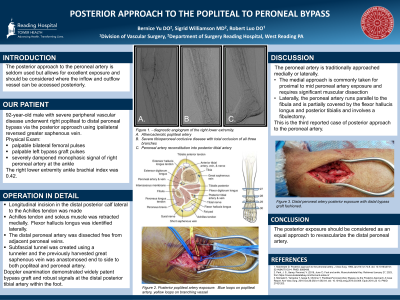Back

Vascular
Category: Quickshot Oral Session 17
Quickshot Oral : Quickshot Oral Session 17
POSTERIOR APPROACH TO THE POPLITEAL TO PERONEAL BYPASS
Monday, February 13, 2023
7:00am – 8:00am East Coast USA Time


Bernice Yu, DO
Resident Physician
Reading Hospital Tower Health, United States
Bernice Yu, DO
Resident Physician
Reading Hospital Tower Health, United States
Presenter(s)
Principal Contact(s)
Objectives: Critical limb ischemia (CLI) is a clinical syndrome at the severe end of peripheral artery disease (PAD) that is marked by ischemic rest pain or tissue loss such as nonhealing ulcers or gangrene. Without revascularization, CLI carries a 30-50% risk of major limb amputation within 1 year. Surgical revascularization is recommended for patient with CLI who have a greater than 2 year life expectancy. We present the case of a 92-year-old male with severe peripheral artery disease with gangrene of bilateral toes who underwent right popliteal to distal peroneal bypass via the posterior approach using ipsilateral reversed GSV. Our patient has a history of left femoral to mid-anterior tibial artery bypass with in-situ GSV. On exam, he had palpable bilateral femoral pulses, palpable left bypass graft pulses, and a severely dampened monophasic signal obtained in the right peroneal artery at the level of the ankle. The Ankle-Brachial-Index of the right lower extremity was 0.42 and right lower extremity diagnostic angiogram demonstrated severe tibioperoneal occlusive disease. Surgical options at the time of presentation included a femoral to peroneal bypass with fibulectomy versus popliteal to peroneal artery bypass using posterior approach. Continued medical therapy was discussed, however due to significant high risk for limb loss without revascularization and the patient’s high functional level, the decision was made to proceed with a popliteal to peroneal artery bypass with posterior approach. The posterior approach provides excellent exposure and should be considered in distal surgical revascularization for which the popliteal artery serves as inflow, and peroneal or distal posterior tibial arteries are target outflow vessels. There is one case report to-date of a popliteal to peroneal artery bypass with non-reversed, in-situ GSV as conduit. The patient also had atherosclerotic disease of the crural arteries necessitating distal peroneal artery for outflow site with P2 segment of popliteal artery as inflow. Our patient had occlusion from the below-the knee-popliteal artery to the distal peroneal artery. Therefore, the posterior approach was undertaken due to superior exposure of both the popliteal and distal peroneal arteries posteriorly. Great saphenous vein was used as the conduit. Critical limb ischemia is a clinical syndrome which carries a significant risk of major limb amputation within 1 year. In the case of distal occlusive disease requiring surgical revascularization, the posterior approach to the peroneal artery allows for improved exposure and should be considered in situations where the popliteal artery serves as the inflow vessel.
Methods:
Results:
Conclusion:
Methods:
Results:
Conclusion:

